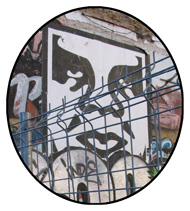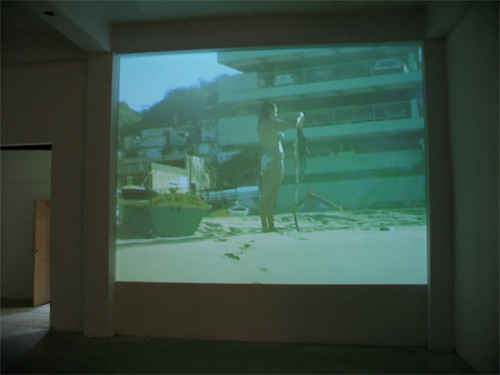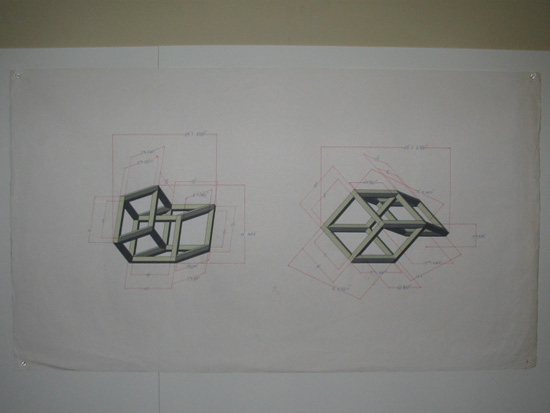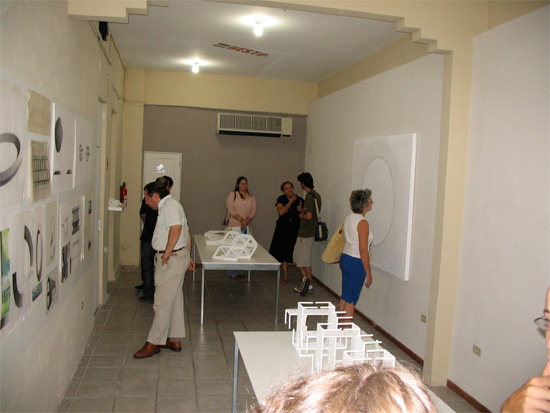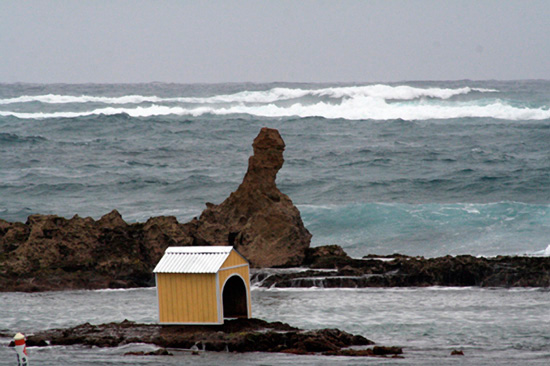|

Is PR Not Splendid? Let Us Count the Ways
1. Carolina Caycedo at Galería Comercial: Caycedo’s Planté Bandera is a four-video installation with handmade flag and photographs, built around the artist’s enterprising activist stance. For the recent Whitney Biennial, she lived in a van and offered services —Spanish lessons, salsa lessons, tailing someone—in exchange for necessities—food, movie tickets, a car vacuum, a place to bathe. She has an essay on the ingenuity bred by survival- level living in the shantytowns surrounding Bogotá, Colombia, in a terrific, tiny book about that nation’s contemporary art scene, ¿Las ilusiones perdidas? edited by María Inés Rodríguez and published by Bogotá’s Taller Arte Dos Gráfico. In her Comercial exhibition, Caycedo puts herself in the street, sleeping on a piece of cardboard as pedestrians stream by, unnoticing; in the midst of a street demonstration against the 2003 American invasion of Iraq; swimming alone through the ocean off the northwest coast of Puerto Rico; and offering the summer use of her house and all its amenities in exchange for a well-equipped computer. It’s a bit of a shame we saw this show after returning from New York. As Rotund readers know, during a visit to MOMA we saw many fine examples of politically-minded art, digestible—even enjoyable—because they are, above all, attentive to aesthetic niceties. It doesn’t hurt to be accompanied by genius, either. Caycedo is no Gerhard Richter or Wilson Sisters, but her videos are well-made and her ideas worthwhile and mostly engaging. The show is at its best in the juxtaposition of the videos Not in My Name—the demonstration —and Planté Bandera (pictured above), in which Caycedo emerges from the water, strips off her outer bathing suit, and plants it like a victorious rebel on the beach. The proximity of chanting, marching crowds and an individual making her way purposefully through a seemingly limitless sea in near total silence achieves a meditative existential frisson, and it carries the works beyond whatever topical relevance they have while never losing sight of the pressing matters at hand. Planté Bandera is on view until March 17 at Galería Comercial, Avenida Fernández Juncos #1600. Call 787-726-1065 and speak to Tito or Luis, or contact the gallery by email— luis@galeriacomercialpr.com and tito@galeriacomercialpr.com—or go to the web site: www.galeriacomercialpr.com.
2. Victor Sosa at =Desto: the =Desteños prove yet again what a supple, interesting, and fun program they’re in the midst of. We’re holding our breath, waiting for art-world realities to put a dent in the sincerity and unstinting jolliness of the principals—Jason Mena, Omar Obdulio Peña Forty, and Raquel Quijano—who bring an intimate, pleasing seat-of-the-pantsness to their enterprise. After a string of successful curated group shows, the crew invited a single artist, Sosa, to do his architectural-looking thing in their space. And what an oddment it is. Sosa makes pencil sketches that resemble precise but preliminary machine drawings—the smudged, folded, and torn paper lends the works their rough-sketch effect—and sculptures that appear to be Styrofoam maquettes for large-scale building projects. One drawing looks like it could portray the clutch for a International Harvester dump truck. Another seems to have giant wing nuts. A tabletop sculpture, looking for all the world like a wacky idea for a suburban split-level home, turns out to picture various configurations of the table on which the sculpture sits. We asked the artist if these are imaginary objects, because for all their well-rendered perspectives they end up looking like a cross between machine parts and sports stadiums. He replied, “No, I fully intend to build them.” Sosa’s talent is his restless curiosity which, abetted by a steady hand, leads him into off-kilter obsessive- wunderkind territory, an enchanted realm filled with elaborate doodling, pretend engineer jokes, and a convincing sense that our public monuments ought to look like the machines that run our lives.
=Desto sits near the corner of Américo Salas and Hipódromo, as we’re constantly reminding you, and we suggest you call Jason, Omar, or Raquel before venturing into the Santurce barrens: 787-633-3381, 787-459-1026, or 787-460-7854. Weekends are probably good, although we’ll wager someone will meet you there at your convenience. Is It Not Also Unsplendid?While we were perusing last Wednesday’s trashcan liner, El Nuevo Día, we came across this curious “news” item by Mario Alegre Barrios, the arts editor at the island’s leading daily newspaper. This supposed “article” was about a new exhibition space opening that very night in Viejo San Juan, called BlackBoxArt (BLKB). The piece was curious in part for what it talked about. Two artists, Celso González and Roberto Escobar, are embarking on a project which they alternately describe as “a business model where different projects and activities are developed to generate economic funds”—a commercial gallery, in other words—and an outfit whose income will be used “to finance grants, public art proposals, and art in general,” like a foundation, something almost opposite. Fine. A little confusion about how things work is not unusual down the rabbit hole of the Puerto Rican art world, especially at its more befogged frontiers. Alegre Barrios went on to report what the two artists were serving up for their blastoff into the artsphere: a selection of works by invited artists which would be a “cultural, sociological, and historical project whose main purpose is to document and spread the artistic movement of Puerto Rico in the year 2007.” Moreover, “BlackBoxArt has undertaken a strategic curatorial selection of 48 Puerto Rican fine artists.” Which, apparently, meant having the artists create works on the “theme,” “Hoy.” Since it is our job to look into anything that has a new-car smell, we dutifully trundled downtown to see this “cultural, sociological, and historical project” with its “strategic curatorial selection,” and we can report—no surprise—it’s nothing of the kind. That is, it has some relevance for the contemporary art world here if you believe that every artist in Puerto Rico is producing paintings that measure exactly 12 inches wide by 24 inches high. “Hoy” is not a curatorial concept, it’s a word you can play with. And while those black walls might be great for boogalooing in a nightclub, they’re otherwise horrorosos. We should not make fun of the BlackBoxers, who are easy targets. We actually love the idea of artists trying to promote their own work, no matter how outré or self-serving. There seems to be, in the Puerto Rican Zeitgeist, a can-do spirit that has bred such admirable projects as =Desto, Área and, if it can still be spoken of as an ongoing enterprise, Carlos Reyes’s tagRom. We don’t even mind how half-assed the notion of “curating” becomes in the hands of many artists since artist-generated shows often reflect a complete breakdown in the interaction between art institutions and the communities they’re supposed to be serving. Anyway, the bone we have to pick is not with BlackBoxArt—we’ll come back in six months and see if the fellows have learned anything by then about the world they’re so eager to inhabit—but with the lack of effort on the part of Alegre Barrios and El Nuevo Día. We happened to grab a press packet at BlackBoxArt’s opening—press packet? plush Fortaleza digs?. . . how do they manage it?—and we were extremely annoyed to discover that Alegre Barrios lifted his “work” almost word-for-word from the press release. The editor’s indifference toward his readership—actually, saying “contempt for” is more like it—is symptomatic of the larger, much-flogged problem of a critical vacuum in regard to the visual arts among island publications. We believe this is one reason that some local artists, art dealers, art world professionals, you name it, have a hard time grasping the scale and heft of what’s going on outside the island, no matter how fine their work or how savvy they are about history and global trends. This lack of journalistic honesty makes it difficult for the non-art-world public to have an accurate picture of just how vigorous and inventive the present moment is—and, on the other hand, the chronic problems we face—and worse, it’s an affront to all those within the art world whose serious efforts find no corresponding response where it’s most needed and expected. Is El Nueva Día irresponsible? Are we disgusted? Somewhere between the sublime efforts of the alternative galleries and the ridiculous waste of our time by the journalistic establishment—and we’re not saying exactly where along the trail—the feisty youths at the San Juan magazine Conboca opened a show of work by staff artists at Candela in Viejo San Juan. Conboca is a rare beast in our increasingly digitized world: a paper magazine of thought and decent stabs at writing, very much in the tradition of the newspaper Rotund World and the literary magazines with zamisdat leanings of yore. Of course, like many a youthful misadventure, Conboca does have a Myspace page, but what hip urban artist-rad does not? We don’t, that’s for sure, but we’re notorious philistine-fogies. We liked the suffocating-yet-pretty video by Ralph Vázquez, Tamara Rivera, and Rebecca Adorno, called Aglublum ionixio eccis—pidgin Latin for “How Low Can You Go”?—and we spent an enjoyable few minutes talking with Rafael Miranda about his color photograph sin título (la peña del perro), which shows a rocky shoreline with an outcropping that does, indeed, resemble a dog if looked at a certain way.
Miranda told us that according to local legend, someone’s faithful friend waited so long for his master’s return that the pooch turned into a rock. The artist built a doghouse, an extremely durable-looking construction, which he placed next to the rock, only to see it carried away eight hours later by the cops. We have no idea how to arrange to visit to the space—we’ve cruised deep into cyberspace, and found only the vaguest details about Candela—but we encourage you to visit Calle San Sebastian between Cristo and San José and go upstairs if the gallery is open. If not, try Candela’s great spaghetti. You can also try email. Thanks to Conboca for providing the image of Miranda’s photograph. Knock Knock Knocking on Heaven’s DoorRotund World may not have much of a future, but it definitely has a past. We’re always proudest of our latest scribblings, and our journey into the sanctums of the New York City art world is no exception. A click on the link below will lead you into bitter snowstorms and equally chilling accounts of visits to museums, galleries, and a hotel room not much bigger than a bread box. That’s why you’re here! New York City here we come. |

